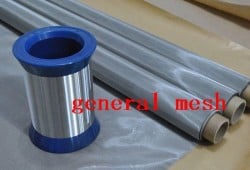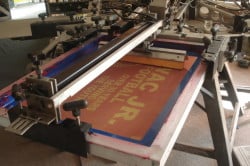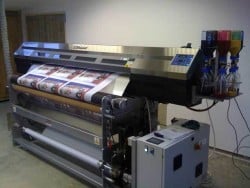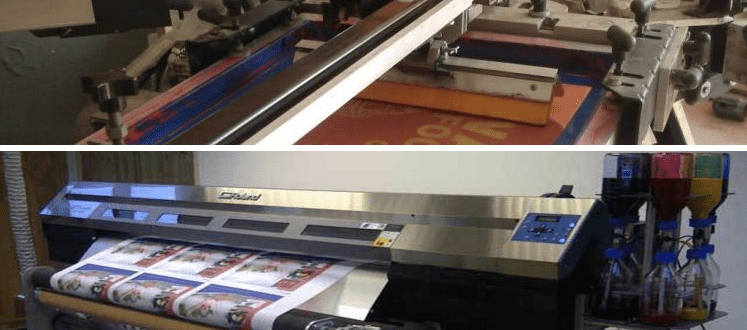This is how dye sublimation printing differs from screen printing.
Question: What is the difference between dye sublimation and screen printing?
The two styles of printing are markedly different. The similarities are that both are printed on substrates and both produce an image. Aside from that? Not so much.
The screen printing process uses a very labor intensive set up that you don’t have with dye sublimation printing.
Screen Printing
I’ll walk you through the screen printing process as I know it quite intimately, since this is where I began my career in the graphics business.
The Screen
 Central to the screen printing process is the screen (duh, right?). The screen is still often called a silkscreen, although silk has not been used for many decades since the advent of nylon thread.
Central to the screen printing process is the screen (duh, right?). The screen is still often called a silkscreen, although silk has not been used for many decades since the advent of nylon thread.
There are many types of screen mesh, starting at around 100 threads per square inch and going up to several hundred threads per square inch. The more coarse mesh is becoming less common as it is used with oil-based enamel inks which have been replaced, by and large, with UV inks, which we run through a 220 mesh count as the ink particulates are much smaller than with the older solvent inks.
The Frame
The screen mesh is typically stretched and glued to a wood or aluminum frame, or attached to expandable frames or roller frames. When stretching the mesh over a frame, we typically take the pounds per square inch (as shown on a “Newton Meter) up to 25 or 26, and let the fabric stretch out over-night.
The Screen Tension
By the time 16 to 24 hours have passed, the meter will show that the tension has dropped off to around 15 pounds per square inch, and we repeat the process, and the screens should have about the proper tension at around 20-22 lbs. per square inch tension, creating a taut screen that will deliver a good, clean print.
Once the screen is tensioned and attached to a frame, we typically use a fabric tape to tape around the edges of the frame, both inside and out. This is a semi-permanent solution to having ink leak out around the edges of the emulsion.
Photo Sensitive Emulsion
 Now the screen is ready for the photo sensitive emulsion, which is applied with a scoop coater, a variable length tray that emulsion is poured into. After applying the emulsion to the screen, we move the screen to a flat, curtained drying/storage cabinet, where it dries. Different systems of coated screen storage will dry the coated screens at different rates, but ours are usually ready to expose within a couple of hours unless we put a fan on them.
Now the screen is ready for the photo sensitive emulsion, which is applied with a scoop coater, a variable length tray that emulsion is poured into. After applying the emulsion to the screen, we move the screen to a flat, curtained drying/storage cabinet, where it dries. Different systems of coated screen storage will dry the coated screens at different rates, but ours are usually ready to expose within a couple of hours unless we put a fan on them.
Post Emulsion and Moving to a Vacuum Frame
Once the emulsion-coated screens are dry, we can now place the film on the print side of the screen, in reverse, tape it in place, and move it to a vacuum frame. The vacuum frame has a large piece of glass upon which the screen is placed, print side against the glass. A “blanket” is placed over the screen frame, and a vacuum motor engaged, and the screen is pressed tight against the glass.
The vacuum frame is now rotated to face an exposure light, which is typically on a timer. The light is turned on, and the photo sensitive emulsion is exposed, but the areas that are behind the film positive remain susceptible to water. After the set amount of time, typically 6 to 10 minutes, the light will turn off, and the vacuum frame rotated back to laying flat, the pressure released, and the screen removed and moved to a washout tank.
Moving to a Washout Tank
There are semi-automated washout tanks which, once you put the screen into it, it will expose the image with water in a short amount of time. At this point we allow the screen to dry, and we’re ready to place it on the screen printing press.
After Checking for Pin Holes
After making sure there are no pin holes (if there are, we use a blockout emulsion to fill them in), we tape the edges to make sure ink won’t leak out around the edges of the print (more of an issue on a clamshell press than one that lifts up and down, leaving the screen flat at all times). We line up the substrate, put in blockers, micro-adjust the screen to the substrate, and we’re ready to print.
The biggest weakness of screen printing is that we have to make a new screen for every color printed, making the set up time for screen printing quite time consuming. However, because the printing process is very fast, if there are a large quantity of signs or decals or banners, etc.
Screen Printing Itself
Next, we pour ink onto the screen, and print whatever it is we’re printing, say, bumper stickers or car window decals or stickers, or window sticker for a business, or signs, or whatever our clients order.
After printing, the excess ink is scooped back into the ink bucket, and the screen removed to a washout tank, degreased, and prepped to repeat the process again.
Dye Sublimation Printing
 Dye sublimation printing of displays and banners is virtually always done on polyester fabric because the chemistry of polyester is suited to dye sub printing. The chemistry involved in dye sublimation printing is fascinating to me, not just because it’s a complex process, but because the end result is by far the most perfect printing of cloth banners, posters, and displays available.
Dye sublimation printing of displays and banners is virtually always done on polyester fabric because the chemistry of polyester is suited to dye sub printing. The chemistry involved in dye sublimation printing is fascinating to me, not just because it’s a complex process, but because the end result is by far the most perfect printing of cloth banners, posters, and displays available.
The Dyes
There are four dyes involved, similar to an inkjet printer. The color coding for dye sublimate printing is a bit different that the CMYK printing that inkjet printers perform. The code for the dyes is CMYO (cyan magenta yellow overprint clear).
The Printing Process
These dyes are printed on a special transfer paper, then removed from the printer and matched up with an oxford, satin, knit, or other polyester material and sent through heated rollers at approx.. 400F combined with the pressure of the rollers. In this process, the dye converts to a gas, and with the aid of the heat and pressure, becomes fused with the polyester fibers, and creates an absolutely gorgeous print (assuming the dyes and polyester are good quality).
Click here for screen printing and dye sublimation printing of graphic displays and the like.
Popular Posts:




